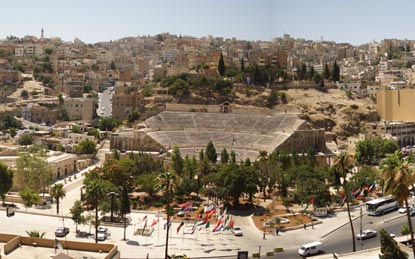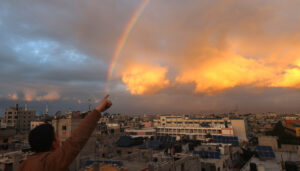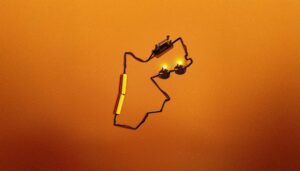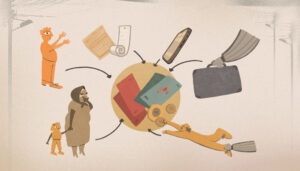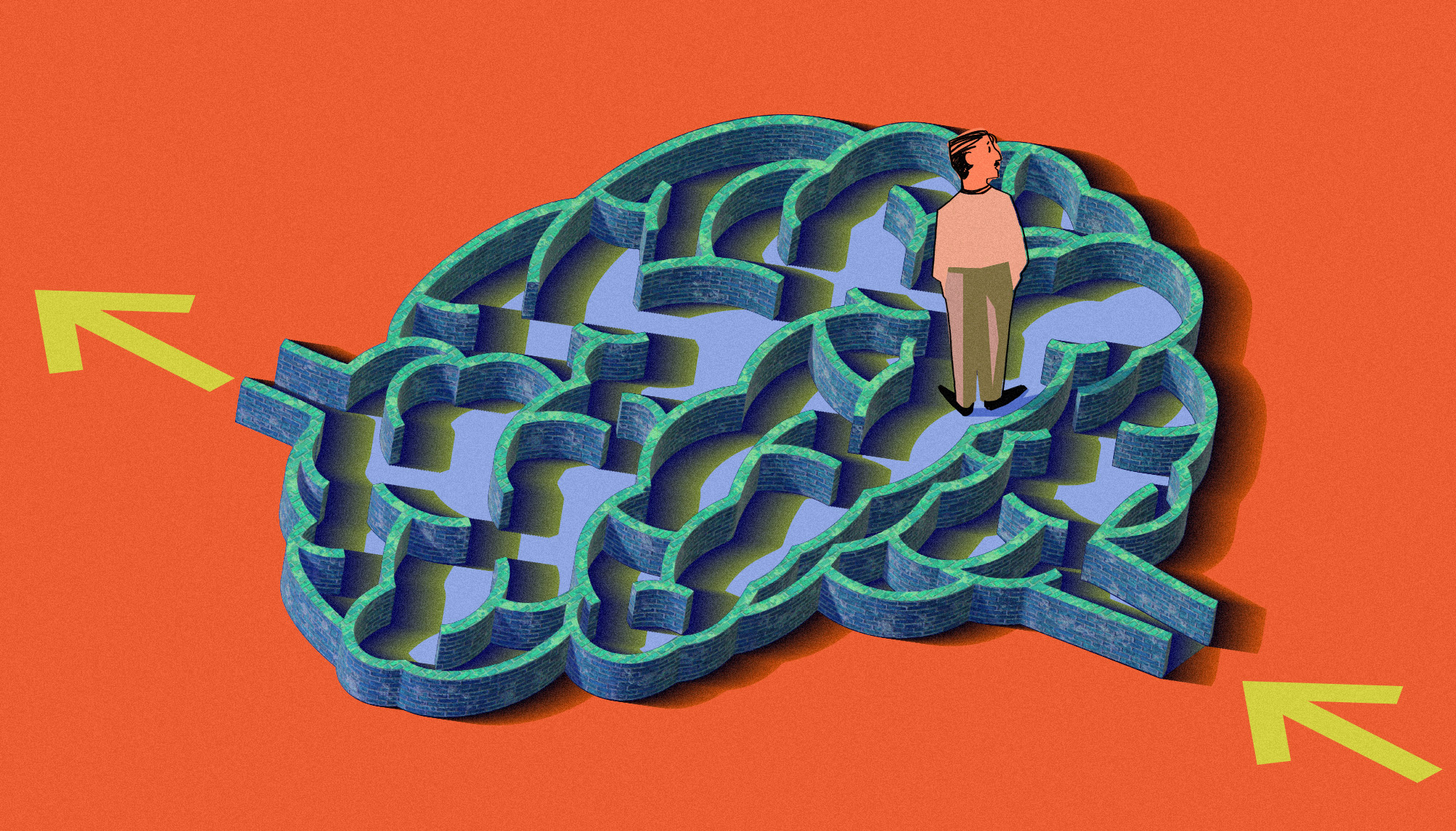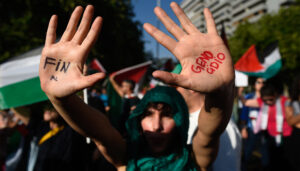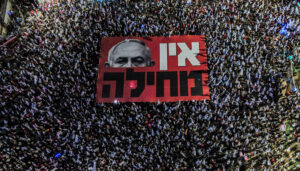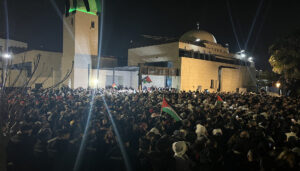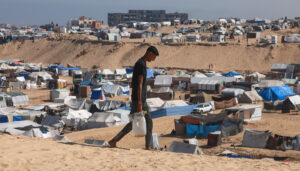Municipal officials have said demolitions are not part of the plan for the historic neighborhood of Jabal Qalaa — but within the local community mistrust still lingers. Part 1 of 3.
Words by Nicholas Seeley. Provided by JO Magazine.
OVER THE LAST FOUR months, a dispute has been simmering between the Greater Amman Municipality, the community activist collective Hamzet Wasel, and some residents of Jabal Qalaa over the topic of the municipality’s new development plans. In May, the issue came to a head when members of Hamzet Wasel aired worries about what they believed was a municipal plan to expropriate and demolish several old houses in Jabal Qalaa, and to construct a wall around the Amman Citadel archaeological site.
Activists asked why the municipality hadn’t consulted the community before it made its plans; the municipality responded that the activists had misunderstood what was going on and were being guided by rumors.
Since then, the dispute has been, to varying degrees, quieted, if not all addressed. The municipality has made some public statements to try and clarify its plans, and held forums and meetings with representatives from the community in Jabal Qalaa. Hamzet Wasel has held discussions with the Mayor, and started working on its own community-centric development plan for the area, which it hopes to unveil soon.
People on all sides have said that that dialogue between activists, the community and the government has been, so far, a success. But many residents of Jabal Qalaa are still seized with uncertainty and even suspicion about their future.
Over the last two months, JO conducted more than two dozen interviews with community members, activists, business and land owners, and local and municipal officials to try and understand what’s behind the debate, and what it means for the future of one of Amman’s oldest neighborhoods.
EVERY DAY WE HAVE different news,” said “Yasser.” The elderly resident of Jabal Qalaa, who did not want his real name used, was interviewed on a scorching afternoon in August, as he sat drinking tea on the narrow stoop of a furniture shop. That very day, he explained, someone had come and told him that the government was going to expropriate houses on the next street down the hill.
Yasser is thoroughly convinced that there’s a plan to demolish his neighborhoodbecause, he said, it’s the only area in Amman where the houses have not been given new numbers by the municipality.
Theories like this abound among the residents of Qalaa. Since April, in particular, stories that houses on the Jabal are going to be expropriated and demolished seem to have been common.
Raghda Butros is one of the founders of Hamzet Wasel, a group of residents of Amman that aims to build relationships between people of different socio-economic, cultural and religious backgrounds, and to engage in social activism in the city. In early May, Butros summed up the concerns about Jabal Qalaa in a public letter about the demolitions project, which was posted on the Creative Jordan website (urdunmubdi3.ning.com).
“The next planned step is to knock down several beautiful 50+ year old houses (with people in them) to build a funicular to link the Roman Theater with the Citadel and there is even talk of knocking down several other homes to sanitize the community for tourists and send the residents elsewhere,” she wrote.
Four days later, the Mayor held a meeting with members of Hamzet Wasel. Nothing was written about this by the group.
Municipal officials were also deeply upset about the situation. In interviews conducted by this magazine in mid-July, officials there said they were still trying to figure out if a funicular was even a feasible option, and that expropriating and demolishing houses was never part of any plan they hadand added that they had explained this in a public meeting in Jabal Qalaa on June 6.
“It’s very easy to … come out with a lie, and then believe it,” HE Mayor Omar Maani told JO on July 18. “Nobody [from the municipality] ever talked about [a project like this]. There is no way we would ruin old houses. They know this. … And what’s funny about it is that after we met [with Hamzet Wasel on May 27] and they were convinced, they still talked about Jabal Qalaa, and the wall.”
ACCORDING TO ACCOUNTS FROM current and former residents in Jabal Qalaa, rumors about expropriation started coming to a head in April or May, after construction began on the new visitor’s center at the Citadel. Butros said the expropriation issue came to the attention of Hamzet Wasel when the group was doing activities with the children in Jabal Qalaa. At one point, one of Hamzet Wasel’s members was refused an apartment, because its owner believed the house was going to be torn down.
The owner of that house, Ibrahim Dawood, told JO in July that he had been certain there were going to be demolitions because he had heard that a group of surveyors from the municipality had come and measured his house.
More than half a dozen other residents of Jabal Qalaa who were interviewed also said they had seen surveying teams therebut they did not know what their intentions were. Those who asked what was going on were told only that the surveyors were from the municipality, or else told nothing at all. It was an easy environment for rumors to spread in.
Dawood admitted that he didn’t see the teams himself, and that he didn’t ask the municipality officially about what was going on. Instead, he says, he went to a personal friend who works in the surveying department; he would not give the name because the friend wasn’t supposed to give out information. Dawood was told that the municipality was thinking of acquiring the building for a new project, but that the whole issue was still in the planning stages.
The municipality was definitely planning something. The idea that there would be a funicular, or “hill railroad,” linking the Citadel and the Amphitheater was told to The Jordan Times as early as November of 2008, and it’s been around in various forms for years. Municipal officials told JO in July that they had been considering a large number of possible routes for a funicular — five or more — but that no route had been decided on yet, and there was no plan to expropriate buildings.
But the story already had legs. In about a dozen short interviews, JO found eight or 10 people on Jabal Qalaa who had heard that houses were going to be expropriated or demolished. Most often the reason for the demolitions was supposed to be the construction of a funicular, though some offered alternate explanations, including big hotels and vague projects created by Gulf or Jewish investors.
However, none of the people interviewed had, themselves, been told by any official that there were going to be expropriations. They all heard about it from friends or neighbors. Saeed Irksussi, one of Dawood’s tenants, told JO that the first he had heard of any project involving demolitions was from a member of Hamzet Wasel itself. Dawood said he heard the story from his tenants. And so it spread.
To make matters more complicated, threats of demolition are not new in the area. A number of houses on the Jabal have been built illegally encroaching on the archaeological site itself. One resident, Mohammad Matar, who lives in one of these houses, said his family has over the years received several notices from the Department of Antiquities, delivered by the police, that their house was going to be demolished — the latest being about a year ago. It happens every time there’s a project in the area, Mohammad said — and nothing ever comes of it.
Several residents said that people were being given notices about the more recently rumored demolitionsbut attempts to follow up on these stories made them sound more like urban myth than reality. No one who told this story had been given a notice themselves — the notice would always be described as having been given to a friend or relative, and always someone who was no longer a resident of the area, and could not be interviewed.
As a final complication, several residents said that a group of private local investors had been telling people their houses would be expropriated, as a way of getting them to sell cheaply. Those investors, who spoke to JO on condition that their names not be mentioned, denied these charges, and said they were developing a different area altogether — an account that one resident of the Jabal confirmed, and some others challenged.
On June 6, in response to growing public concerns, the municipality held a public meeting in Jabal Qalaa to try to address the issues. After the meeting, the Mayor toured the houses that were rumored to be facing expropriation, and assured several people, including Irksussi and Dawood’s cousin, Na’el Bilbeisi, that these buildings would never be expropriated. He also asked the local mukhtar, Firas Zawany, to set up a committee to meet with him and discuss the community’s concerns.
But the rumors of expropriation, it seemed, had already grown too large to deny. When JO spoke to Qalaa residents in August, several, like Yasser, still expected that their houses might be torn down. Others saw the government’s assurances as a policy reversal.
Tha’er, 18, who was interviewed as he walked in the street with a friend, said his family had moved to Zarqa because they were told their house was going to be torn down. At first, Tha’er appeared to say his family had been given a written notice; when reporters asked if he had the notice, he said that actually they were they were told about the demolitions verbally. After moving, Tha’er said, his family read in the newspaper that the project had been “canceled.” None of the major papers appear to have reported this.
The discussion on Creative Jordan continued; as of press time, no one on the site had modified the claim that houses were going to be demolished. The discussion remains the most commented on the site.
WHEN JO INTERVIEWED MAYOR Omar Maani on July 18, he was unhappy about the stories of demolitions — and not thrilled to be asked about them yet again.
“I think they are rumors,” he said. “People fuel rumors and people believe them. People create a lie, and then they believe it.” And he felt that the municipality had made every effort to be clear about its plans.
“I’m being very vocal about it, all the time [but] we’re not in the business of, every time somebody speaks, going out and saying ‘this is the fact.’ We say the facts, once, twice, three times, but we also have to do the work, we have to work.”
But when asked why there hadn’t been a public discussion of the funicular plan before engineers were sent to measure people’s houses, his response was unequivocal:
“I don’t need to do public forums to decide where a funicular is. This is not the business of Mayors, going and saying: ‘I have an idea, and why dont I share it with you and you tell me what we do?’ No. We tell them what to do, and then we show them the options. If we feel that there is sincere and genuine need for us to relocate this, then we will. … We talk after we’ve done our homework. We don’t talk before.”
His municipality is the first to do any consultation with communities, he added.
“These public forums, nobody did them before,” he said. “We are the first municipality and the first agency in the country to do public forums and to listen to people. If we are going to pay the price because we want to open up, then obviously we should not open up.”
SOME OF THOSE INTERVIEWED, like Firas Zawany, the mukhtar, and Na’el Bilbeisi, the property owner, said they had attended some public meetings and discussions about development plans long before the controversy arose — but the meetings were brief, and they did not come away with a come away with a clear idea of what might happen, they said.
And when officials have spoken out about upcoming or ongoing development projects, there have often been mixed messages.
One example would be the second major issue brought up by Hamzet Wasel: the idea that the municipality was building a wall around the Citadel archaeological site. Traditionally, the site has been unfenced, and the southern slope, in particular, unmonitored. Local children were used to being able to play at the site, and the inhabitants of Jabal Qalaa could often access it informally.
But since April, when construction began on a new visitors’ center, parking lot and events plaza for the site, members of the local community and advocacy groups have been worried. A high stone wall was built on the north side of the site — according to municipal sources, this was to hide the bus parking from the road, but some thought that the wall would completely enclose the site.
In her public letter, Butros cited the claim that a wall was being built around the Citadel. On May 11, she added a new post, saying she had been assured that the wall would not go around the entire site, but that she was told there would be “a fence of some sort, but it’s still not clear what it will look like or whether access to the site will remain free and open to all.”
Both at the time, and later, in July, multiple municipal officials said clearly that there would be no fence, and that community access would remain as it was.
“At the Citadel, there has long been a casual arrangement for access by locals and there is no intention to change this, in fact quite the opposite. The Citadel will continue to be ‘open’ from the west and southwest sides of the site, for those with the local knowledge or adventurous means,” wrote Faten Al-Masri Kamal, the mayor’s communication advisor, on Creative Jordan, on May 23.
“People quickly came to the conclusion that we are building a wall around the facility, which is completely untrue,” said the Mayor.
But in an August 3 interview, Department of Antiquities General Director HE Fawwaz Khraysheh said that some new measures to protect the park were going to be necessary — possibly including a fence.
“Fencing the site, this is a way to protect it,” he said. “If I’m going to give accessibility to kids, and to people just to play there, I’m not going to be sure about the protection of those sites.”
Access might continue to be free of charge for the local community, he said, or at least discounted, but it would be regulated, not completely open as it is today.
“There should be a regulation, not free like nowadays. It’s time to regulate it. … This is not a public park; this is an archaeological park, and there is a big difference between a public park and an archaeological park.” His department was also considering other incentives, he said, including encouraging organized community activities in the new events plaza, and offering reduced rates for its use by people from the area.
The municipality was asked again about this issue, on August 11, but could not provide clarification by deadline time. In interviews in August, some residents of Jabal Qalaa still thought they would not be allowed to enter the Citadel archaeological park.
NEARLY EVERYONE INTERVIEWED OFFERED their own vision of what kind of neighborhood Jabal Qalaa is. To some, it’s a run-down area, inhabited mostly by migrant workers and plagued by crime. To some, it’s a tight-knit community that embodies the history of Amman. To others it’s an archaeological treasure; to others still, a semi-impoverished area with minimal services, that needs renewal and revitalization.
The differing views did not represent “factions:” indeed there were almost as many differences of opinion between municipal officials as between members of the local community, not to mention land owners, private developers and activists. With every viewpoint came a different theory on how best to fix the area’s problems.
The municipality has had the unenviable job of trying to steer a course between — or through — these conflicting narratives. But some complaints were close to universal: most sources said that the Jabal had been neglected for years, that it lacked both public services and a thriving private sector.
“Even if I want to buy bread, I have to send my kids halfway across town,” said one woman, who spoke to reporters from the porch of her home, where her children were playing.
Many sources also complained about the large number of abandoned or unused buildings — some of which have become home to squatters, and gained an unsavory reputation, residents said. A common fear was that the entire community was being judged by a few run-down areas. It’s a fear these interviews indicate was not unjustified.
On July 23, a group of representatives from the community, selected by Zawany, along with a representative from Hamzet Wasel, met again with the Mayor. The Mayor made a number of promises in terms of local development: to resurface and repair streets and staircases, to improve sanitation and waste disposal services, and to find a space where a public square could be constructed for community events.
In the July 18 interview, the Mayor had insisted that expropriations might at some point be necessary, if it was for the benefit of the area. But in the meeting. a week later, he promised there would be no expropriations at all — a promise that was reported on July 25 on the municipality’s web site.
The meeting also produced a plan to deal with some of the abandoned buildings on the Jabal, Zawany added. The hope is that the municipality will be able to buy the buildings from their owners — often large groups of inheritors — and remove or rehabilitate them, he said.
One project that has already started is a major renovation project of the local boys’ club, which had fallen into severe disrepair. (There is no club for girls on the Jabal, said manager Imad Nawras). At press time, the entire building was in the process of being repaired and painted. The plumbing, electricity and windows were also scheduled to be fixed, Nawras said, and he expected new fittings and air conditioners soon.
But responses to the meetings and public forums were still mixed. Many were positive.
“This is the first mayor in the history of Jordan who cares about the Jabal,” Zawany said. “If he does what he promises, the Jabal will be different within one year.”
Nawras said the Mayor was implementing projects that would benefit the image of the area for visitors, particularly at the Citadel. “Instead of seeing ruins, they’re seeing things that are new and modern,” he said.
But other residents, particularly those interviewed at random on the streets, remained unconvinced that the work would benefit them.
“I think they’re doing this just for the tourists, not for the people,” said one resident, interviewed walking down the streets of the Jabal, drinking juice. He complained about the municipality kicking families out of their homes after years of living there.
Mohammad Al Homsi is a young man who works in a vegetable shop, but often leaves work during the day to help with repairs to the boys’ club, about which he is tremendously enthusiastic.
“This is the only place where we sit. When we finish our work, we come and sit here,” he said.
But he admitted he was not sure about the development project as a whole — or what he understood of it. “It might be good, it might not be good,” he said — then was quickly cut off by Nawras: “Be careful what you’re saying — they’re recording!”
Even among those who had attended the June 6 public meeting, a large number of people said they still didn’t understand what the plan was all about, and didn’t have access to information about it.
“They feel like they live in the unknown,” said Zawany, who believes there’s no way for local people to get information from the government. “The only person who knows is the Mayor. Anybody below the Mayor doesn’t know what’s going to happen,” he added.
“There’s no place we can go for information, not one,” said Mohammad Matar. Several other said they had gone to the municipality to ask about the expropriation rumors, or to ask for more services in the area, and had received no response.
But a few blocks up the road from where Mohammad was interviewed, Talal Hattab, owner of perhaps the only cafe on Jabal Qalaa, said that it was easy to get information from the municipality. Even so, he also admitted he didn’t know what was planned. The municipality “had their own ideas“ about the area,” he said — a common phrase among residents.
The municipality’s website provides outlines of some of its development plans, and the phone numbers of different departments, including general information, but it did not seem this was a resource people on Jabal Qalaa were using, or finding effective.
WITH LIMITED INFORMATION, PEOPLE rely on rumors or past experiences — not always positive ones.
Yasser told reporters how 10 years ago the municipality had expropriated some buildings on the Jabal in order to create a small garden. The garden was partially built, but never followed up on, and soon fell into disuse. Today, it is a half empty collection of concrete walls, in disrepair and filled with garbage. This was what always happened, Yasser said: the government would get excited about a project, start work, and then abandon it.
Zawany said the municipality had recently promised to refurbish the garden, and to extend it as a path down to the amphitheater. The municipality was not able to confirm this by press time.
Throughout the interviews for this piece, it was common to hear residents and local officials talking about the government’s “hidden agenda.” Some of these “agendas” were clearly baseless; others were informed by past experience.
For example, several residents feared that some party had been misinforming municipal officials about the area — portraying it as a hotbed of drugs and crime, to encourage the government to clear out the residents and redevelop it for tourists. He believes there’s a precedent for this: Zawany is also a member of the downtown trader’s union, and he described how a previous municipal government had carted garbage into the downtown area and dumped it there, in order to secure approval for the building of the Raghadan bus station — another project that went nowhere.
Laith Irksussi, Saeed’s son, said he believed the municipality plans to pedestrianize the downtown area in order to cause the shops there to fail.
Laith said he hadn’t gone to the public meeting — he didn’t believe anything would come of it.
“I will not bother myself to go to meetings like this, because you’ll be wasting time. We’ve seen what happened with Talal Abu Gazaleh and the Abdali project. [The municipality] will not change their minds — end of story.”
There may be no real evidence for these conspiracy theories, but it’s clear they are often based, to some degree, on real events that people feel have never been fully explained.
THE MAYOR SAID HE saw little point in paying attention to such stories.
“You can always find people that are complaining,” Maani said. “I’m not in the business of pleasing everybody. If some people are convinced, then it’s good; if other people are not convinced, then we’ve done our best. We’ve tried to communicate.”
“The communications strategy for the Mayor is not one that is reactive; actually it’s very proactive,” added Kamal, the communications manager. “In addition to the weekly meetings with the families, the mayor is on Twitter, he’s on Facebook, he’s got a blog, we’re revamping our website, he goes on TV.” She also mentioned that the municipality had its own radio station.
But overall, the picture that emerged from local interviews was of an area where accurate information was hard to come by, where people have very different perceptions of their right to approach the government, where public officials leak information that may or may not be true, and where nearly everyone relies on rumors.
In July, Butros said she still believed the municipality had intended to demolish houses, and that her group’s activities had caused them to reconsider the plan. Municipal officials still maintained that they had been attacked unfairly. Both groups are now consulting with the local community in Jabal Qalaa and, for the moment, that consultation appears to be producing some positive results for the community.
“This is not an issue of Hamzet Wasel versus the municipality,” Butros said. “It’s actually the opposite. The whole purpose of Hamzet Wasel is to get the people of the city together. … A lot of times, people who are in the field of development approach communities from the element of: ‘Well, what’s the problem with the community? What is wrong with the community? What are the problems the community’s facing?’ We wanted to approach it from a different perspective … to look at communities as resources.”
But it also appears that neither the municipality’s communication strategy nor the efforts of community activists like Hamzet Wasel have succeeded in helping most members of the community understand what is happening in their neighborhood, since so many of those interviewed continue to have little idea what the plan for the area is, what it means, or how it will take shape.
Next week: Go beyond the rumors. What we’ve learned about the municipality’s real development strategy for downtown and Jabal Qalaa, what the funicular project is really all about, and how it’s expected to benefit the city.
Mariam Abu Adas, Laith Abou-Ragheb, Omar Hijjawi and Haneen Ababneh contributed translation and reporting to this story.
